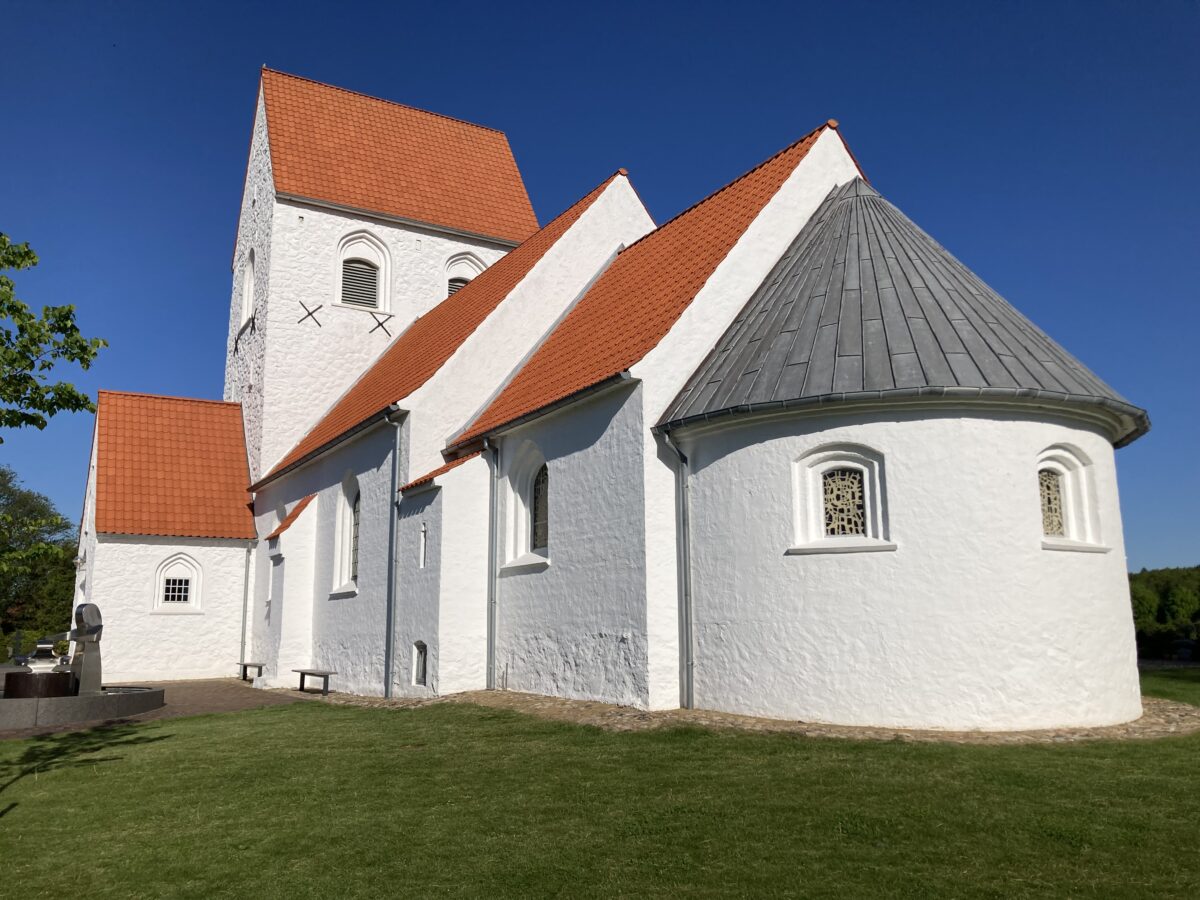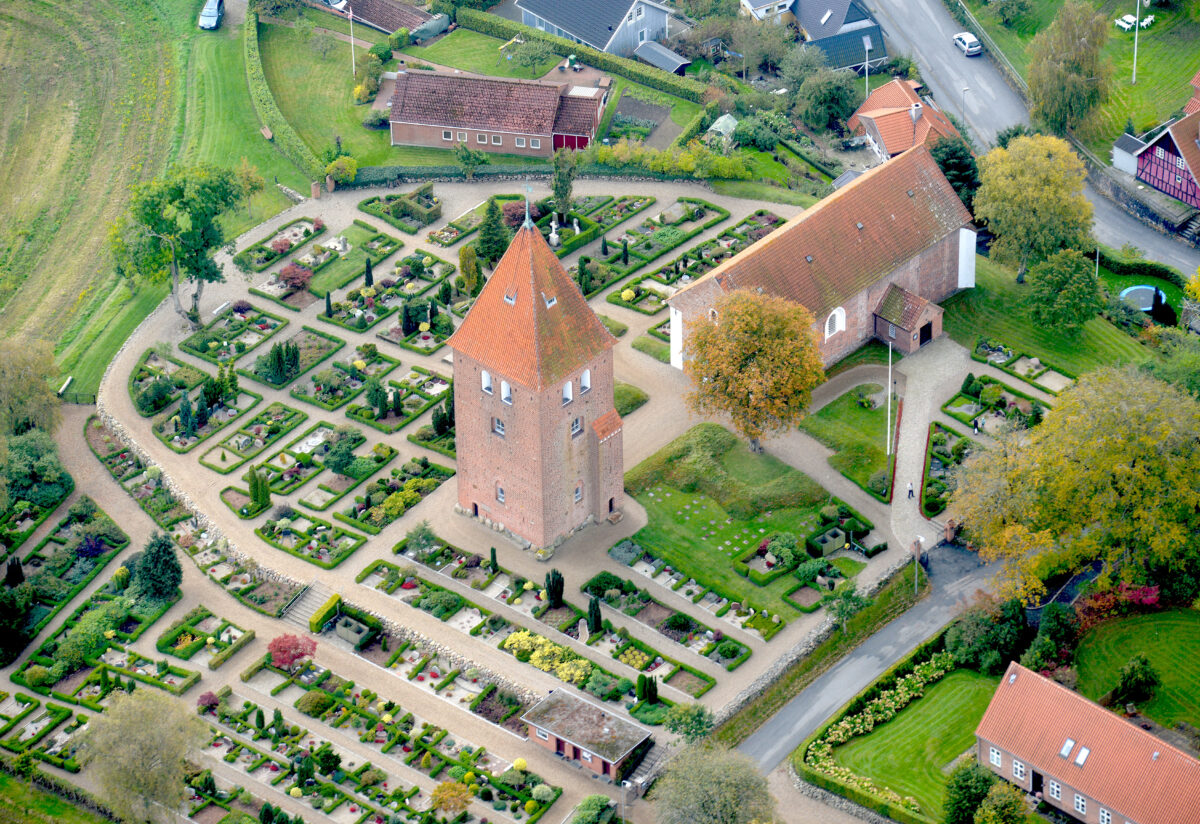Home / Aktiviteter / Visit attractions / Churches and monasteries / Churches and monasteries north

NORTH - The Land of Bargemen
Churches and monasteries north
Below you can read about the monasteries that were located between Silkeborg and Randers in the Middle Ages, as well as some of the churches you can visit today.
Tvilum kirke. Foto: Kristoffer Uhre Knattrup
Monasteries in the Land of the Pram Dragons
Tvilum klosterkirke
Augustinian monks founded Tvilum Monastery in 1246. The monastery church is well preserved, while the monastery buildings that lay to the south of the church have been archaeologically proven. From research, it is known that the monastery was three-winged and the church formed the fourth wing. The four wings enclose a monastery courtyard. Around 1500, a very large closet altarpiece was erected, which is still in the church. The monastery was dissolved in 1537.
The church is beautifully and prominently located down to Gudenåen. There is a bridge below where canoes can dock. If you come on the towpath, you can see it from the opposite bank.
Find Tvilum church on the Gudenå map

Tvilum kirke. Foto: Kristoffer Uhre Knattrup
Monasteries in the Land of the Pram Dragons
Sminge Kloster
In 1165, a group of Cistercian monks from Vitskøl Monastery in Himmerland were sent to establish a new monastic foundation in Central Jutland. Their first place was 'Små-enge' - Sminge, where they arrived in 1165-66. The foundation of the monastery is known from the Chronicle of Øm Monastery, where the monks report that the place was too poor and inadequate, so they quickly moved on to Veng.
In one area here, remains of medieval graves and a few foundations have been found, possibly originating from Sminge parish church. The church site is seen as a slight rise in the terrain on the north side of Voel Å in the low and flat landscape on the right bank of Gudenåen, south of its outlet in Sminge lake.
Find Sminge monastery on the Gudenå map

Sminge Klostertomt
Monasteries in the Land of the Pram Dragons
Alling kloster
Alling Monastery was a Benedictine monastery from around 1250. The monastery was originally built at Vejerslev ca. year 1200 and moved about 50 years later.
The vegetation on the monastery ruins is mowed annually so that the old foundations are visible.
Find Alling monastery on the Gudenå map

Alling Klostertomt
Monasteries in the Land of the Pram Dragons
Vejerslev kloster
Vejerslev Monastery, which is probably a Benedictine monastery, was probably founded in the 12th century, but already in the first half of the 13th century the monastery was transferred to Alling Kloster. Of the monastery buildings, only the church, today the parish church Vejerslev Kirke, remains.
Find Vejerslev church on the Gudenå map

Vejerslev Kirke
Monasteries in the Land of the Pram Dragons
Gråbrødrekloster in Randers
The monastery was founded in 1236 by Franciscan monks - also known as Grey Friars. The monastery was closed in 1530. Despite the fact that several archaeological excavations have been carried out on the monastery site, there are many unanswered questions about the monastery and its church. However, it is known that in the late Middle Ages, the monastery was a four-winged structure with the church as the north wing. Reconstruction: Lasse Nielsen, Middelalderkanalen
Read more about Gråbrødrekloster

Gåbrødre Kloster, Randers. Visualiseret af Lasse Nielsen, Middelalderkanalen
Monasteries in the Land of the Pram Dragons
Helligåndshuset
The monastery was established in 1485 on the basis of an older holy spirit house (from 1434). In connection with the foundation of the monastery, King Hans donated St. Morten's church to the monastery. The old St. Morten's church was demolished and the new one inaugurated in 1494. The monastery served as a general hospital for the sick and elderly. The church functioned as both a monastery church and a parish church. In 1541, the hospital is closed down and merged with Vor Frue Hospital in Aarhus.
The monastery was hardly completed before the Reformation and its extent is unknown, but a monastery wing called the Holy Spirit House is preserved. The church continued as a parish church after the Reformation. The church's choir dates from 1494 and the three-part nave from the 16th century.

Foto: Kim Brandt Thomsen, Randers Kommune
Churches in Pramdragon Country
Silkeborg kirke
Silkeborg Church is from 1877 and Silkeborg's first church. When the paper mill opened in 1844, only a few people lived here, but eventually the town grew - and needed a church. The church is a Romanesque-style chancel church designed by architect Sibbern.
Find Silkeborg church on the Gudenå map

Churches in Pramdragon Country
Svostrup kirke
Svostrup Church is located at the old ford across the river Gudenåen to the noble and royal road from Skanderborg to Viborg.
The church was built in the late 12th century in Romanesque style, without a tower and with flat ceilings in the choir and nave. During the High Catholic period 1460-1470, vaults were put over both the choir and nave, and new frescoes were added. These murals were later whitewashed over.
The nave and tower were added in 1788 by then church owner Jean Arnold Fischer of Allinggård.
In 2006-07, the church underwent a thorough renovation, which included uncovering the old frescoes from the 15th century.
Find Svostrup Church on the Gudenå map

Churches in Pramdragon Country
Bjerringbro kirke
Despite its medieval appearance, Bjerringbro Church was inaugurated as late as 1919.
The church has since changed its appearance twice. In 1957, the rectory and apse were added, and in 1961 a side aisle and baptistery were built.
Before the church was built, Bjerringbro's inhabitants were divided between the three parishes of Bjerring, Hjermind and Gullev.
Find Bjerringbro Church on the Gudenå map

Churches in Pramdragon Country
Ulstrupbro church
People in Ulstrup wanted their own church after World War II. The Ministry of Church Affairs would only pay for half of the church, so the townspeople had to find the other half of the money themselves. The land for the church was inherited by the city. They raised DKK 85,000 and were allowed to start construction. The total construction was estimated to cost DKK 325,000, so the goal of covering half of the cost themselves had not quite been achieved. But an agreement was made that the church could be built in stages, and they were allowed to start construction. They started with the nave in 1952. And in 1961, the city had enough money to add a choir, apse and church tower, while extending the nave by 6 meters. Ulstrupbro Church had another construction period from 1988-1995, when money was given to make the church more beautiful. It was for lights, art and organ. And with this construction period, the church finally looked the way they had envisioned it back in 1948.

Churches in Pramdragon Country
Langå kirke
Langå Church is an old medieval church and the oldest building in the town. The original church, which consisted of a nave and chancel, is thought to have been built around the 13th century, while the tower and porch were probably built in the late 15th century. Since then, there have been several rebuilds and repairs to the church, including in 1956, when the nave was extended by 6 meters, the tower raised and the choir widened. In the same year, the side aisle was built and the fresco by Ernst Trier with motifs from the Gospel of Matthew was painted.
Find Langå Church on the Gudenå map

Churches in Pramdragon Country
Grensten kirke
The current Grensten church was built in 1885. In connection with the church's 125th anniversary in October 2010, it underwent an extensive interior renovation. The former church was a Romanesque granite ashlar church consisting of a chancel, nave, porch to the south and a ridge turret over the west gable. In October 2010, Henning Toustrup found a document at the Danish National Archives. It was a report of an extraordinary church inspection in 1880, and in this document there was a drawing of the former church's exterior and a floor plan. These drawings are the only known drawings of the former church.

Churches in Pramdragon Country
Ørum kirke
Churches in Pramdragon Country
Sct. Mortens kirke
St. Morten's Church was built in red monk's stone as part of a large monastery complex in the late 1400s and early 1500s. A Latin inscription above the altar tells when the choir was completed. The inscription reads: "In 1494 Prior J built this, or rather God." Prior J refers to the monastery headmaster Jens Mathiesen, who was also responsible for the construction of the Holy Spirit House, which was part of the Holy Spirit Monastery.
The Reformation slowed down the expansion of the Catholic monastery. Sct. St. Morten's Church was named a parish church in 1534, two years before the official farewell to Catholicism in Denmark.
Find Sct. Mortens Kirke on the Gudenå map






